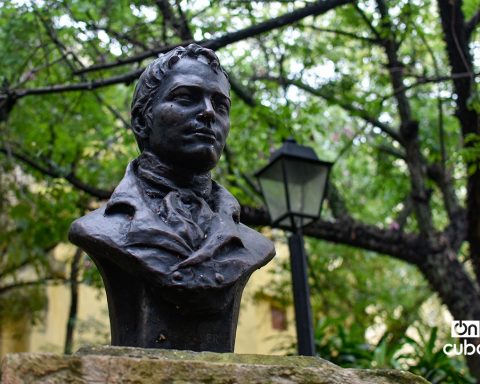Provincetown, United States | AFP | After hours of cruising Cape Cod Bay and a few false alarms, occupants of the research vessel Shearwater made their first sighting on a clear April day: three North Atlantic right whales, including a rare mother-calf pair.
The captain stops the engines and a trio of marine biologists spring into action, quickly snapping photos and annotating marks that can be useful in identifying specimens and tracking injuries, a vital part of conservation efforts for a species estimated to number only 336. copies.
Although the whaling that nearly drove them to extinction has long been outlawed, collisions with ships and occasions when they become entangled in fishing nets are today the main threat to Eubalaena glacialis, one of the most endangered mammals around the world.
At nearly 60 feet long and weighing more than 70 tons, North Atlantic right whales are the third largest in existence. Their life expectancy is similar to that of humans with individuals living up to a century.
“Unfortunately, since 2010 their population has been in decline,” explains Christy Hudak, leader of the Center for Coastal Studies, on an expedition that departed from Provincetown, a New England fishing enclave in the United States, popular for whale watching and tourism. gay.
“We try to get the word out about these fantastic creatures and how they are one of the key species in the circle of life.”
The team from the research center coordinates with an aerial reconnaissance plane, while another part of the group flies minidrones equipped with cameras from a boat as part of a study to assess the impact of fishing nets on the growth rate of these whales.
Despite strict boat speed limits in some protected areas and new rules put in place by authorities to limit the number of nets between buoys and crab and lobster traps on the seabed, conservationists fear it may not be enough.
The problems are compounded by climate change: as North Atlantic waters warm, a small, oil-rich crustacean called Calanus finmarchicus, the main food source for right whales, is becoming rarer in its habitat, extends from Florida to Canada.
Cape Cod Bay is not warming as fast as the waters further north in the Gulf of Maine, and so it is here, in their traditional breeding and feeding niche, that these sea giants are most commonly sighted.
Aside from photography and note-taking, the crew also conducts plankton surveys, casting nets and using water pumps to take samples at different depths for laboratory analysis.
Knowledge about the composition and density of zooplankton helps scientists predict the arrival and departure peaks of whales.
The “ideal” whale
Right whales were the favorite prey of commercial hunters for more than a millennium – by Vikings, Basques, English, Dutch and finally Americans – who sought their blubber for whale oil and their baleen – with which they filter their food – as strong and flexible material used before the era of plastic.
According to David Laist, author of a book on this species, its number before commercial whaling reached about 20,000 individuals, but at the beginning of the 20th century the species was decimated.
There was only one confirmed sighting somewhere in the North Atlantic between the mid-1920s and the 1950s, Laist writes.
“The first whalers thought it was the ideal whale for hunting because of its value, large layers of fat to produce lamp oil,” says Charles “Stormy” Mayo, founder of the research group Center for Coastal Studies.
A recent birth boom in the 2000s led to a peak of more than 483 animals in 2010, but numbers are on the decline again and in 2017 the species was hit by mass die-offs due to changing feeding grounds.
“Fourteen right whales died in a very short period of time when they moved into an area in the St. Lawrence Gulf that was previously unknown and unmanaged,” the expert said.
Such displacement due to a decline in prey abundance appears to have been caused by climate change, and left the whales highly vulnerable to the collisions and nets that killed them.
And since the population is already depleted, even a few deaths are enough to trigger a downward spiral, explained Mayo, who was part of the first team to untangle a whale in 1984. Mayo’s own father hunted pilot whales, and his family lived in the area since the 17th century.
The rate of whale births in waters further south has also decreased.
If three years is considered the normal interval between births, the current average is between three and six years, according to the National Oceanic and Atmospheric Administration (NOAA).
Stress in females – caused by non-fatal entanglement with nets and noise in the ocean from human activities – would be behind the steep decline.
Playful pups and whale party
Right whales are distinguished by their stocky appearance without dorsal fins, as well as their heads adorned with gnarled patches of rough skin called calluses, which are colored white by small “whale lice” (cyamidae) clinging to their hosts in what it is believed to be a symbiotic relationship.
Following advice from his colleagues from the air, the Shearwater finds more right whales including a playful calf that mimics its mother and a gathering that biologists call a surface active group, an opportunity to socialize.
The whales “assemble by spinning around and touching each other. The goal is to mate but also just to interact with other right whales. It’s not always for sex,” Hudak says.
Back on land, Hudak says she was motivated by what she saw throughout the day: a total of 10 right whales, two mother-calf pairs, and a social group, the “main course.”
The long-term future of this species is still far from assured, but there is hope.
New technologies are being tested to reduce entanglement, from weak nets that can break more easily to stringless fishing traps that use remote-controlled floats.
Other ideas include deploying more acoustic monitoring devices on buoys to track whale movements by responding better and faster with speed limits to ships in such areas.
It is also vital, according to Hudak, to increase public awareness to protect these creatures.
The ship’s observer, Sarah Pokelwaldt, a recent graduate doing an internship at the research center, said she was impressed by what was her first sighting of calves.










